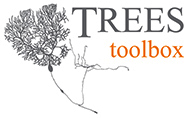
adapted from
PLoS supp. material
by Hermann Cuntz

![]()
Segev and colleagues derived a new representation of neuronal trees
depending on electrotonic measures.
The method used for this representation was called the “Morphoelectrotonic Transform”
(Zador et al. 1995, J Neurosci 15(3):1669-82).
In fact, the method used in that case is very generalizable.
Any Nx1 vector of length values may be mapped on a tree with N nodes.
This is done by scaling the length value li of all segments
to the new segment lengths while conserving the direction of the segment indicated
by the direction vector (arrow below).
At each step the entire sub-tree needs to be translated accordingly.

Only in the case of 0-length segments, a direction needs to be picked arbitrarily. A TREES toolbox function (see “morph_tree”), performs this type of morphing operation which can have various applications of which the morpho-electrotonic transform is just one.
On the path sum (see “Pvec_tree”),
child sum (see “child_tree”),
segment binning (see “bin_tree”)
parent daughter ratio (see “ratio_tree”),
are further examples of such “meta-functions” which apply an Nx1 vector
on a tree structure to result in a wide variety of applications.

This work is licensed under a
Creative Commons Attribution-Noncommercial-Share Alike 3.0 License